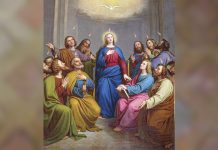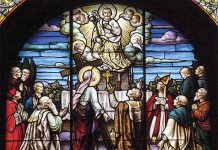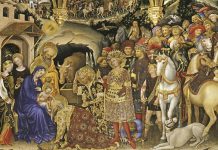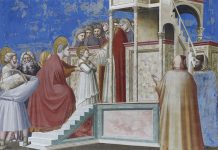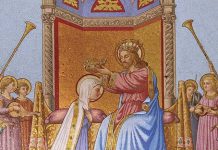After analysing the treasures contained in the first words of the Hail Holy Queen, Msgr. João continues his comments on this famous prayer, bringing to light marvels about Our Lady and her mission among men.
The Salve Regina prayer refers to three important titles of Our Lady: “hail, our life, our sweetness and our hope.” Is there any connection between these invocations and the prior ones? Or, are they merely literary adornments?
If examined carefully, it can be seen that they are the result or practical application of the first invocations and the fruits of mercy.1
“Our life”: essence of the Secret of Mary
To claim that something is a person’s “life” means that their existence would be meaningless if deprived of the element under consideration. Thus it could be said that the reform of the Cistercian Order undertaken by St. Bernard of Clairvaux was his life, because in it he found the purpose for which God had created him. In a similar way, for a Knight Templar the defence of the Church and of the Holy Places against the fury of the infidels was his life, that is, the object of his joys and hopes in the midst of the sufferings and vexations of earthly reality. The same definition could be applied to St. Elizabeth of Hungary, who made the service of the sick her joy and her life.
For an analogous but more exalted reason, calling Our Lady “our life” constitutes one of the deepest aspects of devotion to her, certainly related to the very essence of the Secret of Mary.2 Why?
As we reflect on the mystery of the Incarnation, especially the gestation period of the Child Jesus in His Mother’s most pure womb, an extraordinary fact calls our attention: the God-Man wanted His life, for nine months, to be a participation in Mary’s life, sustained by, and dependent upon Her. Something of His human life was subject to the existence of Our Lady.
Therefore, it will be up to future theology, in its speculative dynamism and eagerness to know the ultimate truth about the mysteries of God, to raise the question: if Christ wanted to depend on her life in time – to the point that the Child Jesus, with all propriety, could exclaim in Mary’s virginal womb: “My Mother, life of my life!” –, would not something of His divine and eternal life depend on Her also? And, as the question is not posed in an absolute sense, in what way and with what nuances? Would this dependence not obey a sublime criterion that would govern the relationship of the Incarnate Word with creatures? In fact, although there is in Him a duality of natures, divine and human, the unity of Person is preserved by the hypostatic union in the Second Person of the Most Holy Trinity. Thus, the Child whose life the Virgin sustained in her womb was God Himself.
the reform of the Cistercian Order undertaken by St. Bernard of Clairvaux was his life;
for a Knight Templar, the defence of the Church and of the Holy Places against the fury of the infidels was his life; and for St. Elizabeth of Hungary, her life was the service of the sick
Mutatis mutandis, a phenomenon similar to that which happened to Jesus during His gestation should take place in those whom Our Lady introduces into her Secret: She will sustain them with her existence and feed them with her virtues.3 Through this maternal bond, Mary will become the life of her children on the salvific and supernatural plane, and they will no longer be able to think, desire or act without Her. To participate in the life of the Blessed Virgin in this way constitutes the highest degree of union with God and the deepest yearning of souls who aspire to perfection: “My Mother, give me the grace to live within Thee as the Child Jesus lived for nine months. Be the reason for my existence and the life of my life. Amen.”
Vessel of the sweetness of the Heart of Jesus
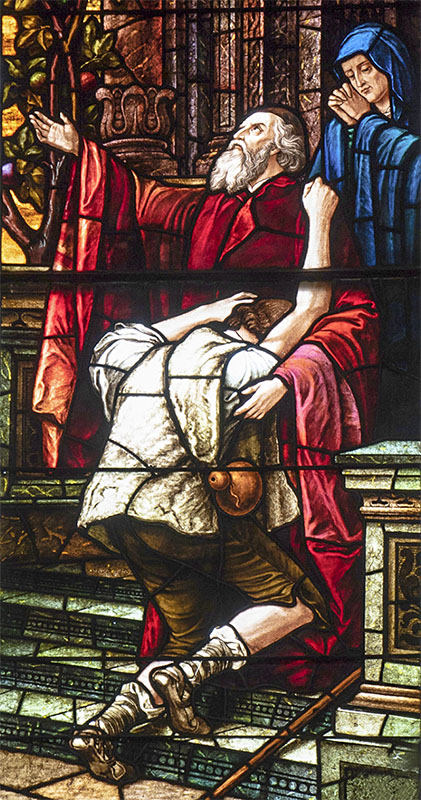
Our Lady is also “our sweetness” when we humbly turn to Her. This sweetness is manifested in the affability, condescension and kindness with which Mary welcomes us, even when we are in the worst and most regrettable state of soul. With even greater solicitude than the father in the parable of the prodigal son (cf. Lk 15:11-32), She goes out to meet her son who is injured and ragged, embraces and kisses him, anoints his wounds with balsam, clothes him with the best tunic and holds a great feast to celebrate the recovery of that fruit of her womb that had been lost.
As Mother of God and ours, She envelops us with affection, softening the hardships and sufferings of this valley of tears, and imparts to our hearts renewed courage for the battles that still await us. Our Lady manifests herself as “our sweetness”, both when She removes obstacles from our paths and leads us through the paradisiacal gardens of interior consolations, and when She allows us to pass through spiritual aridity, setbacks and even failures, like unto her Divine Son on the Cross. In every circumstance She obtains for us the graces, virtues and strength necessary to be the warriors and heroes of her glorious Reign.
How bitter is the life of those who embark on the path of sin and reject the tenderness of this Mother, whose Immaculate Heart is the vessel of the sweetness of the Sacred Heart of Jesus!
Mary welcomes us, even when we are in the worst and most regrettable state of soul, with even greater solicitude than the father in the parable of the prodigal son
Hope full of joy and confidence
The triad of praises to Mary Most Holy ends with the invocation “our hope”. This virtue refers above all to future glory (cf. Rom 5:2), but it also embraces the spiritual and temporal interests of the present life. As St. Thomas teaches,4 it is through this virtue that evils are avoided and good is sought, for one only hopes for the good that one desires and loves. Moreover, hope brings with it a foretaste of the joy of soul in possessing the good desired,5 and for this reason the Apostle exhorts: “Rejoice in your hope” (Rom 12:12).
The Salve Regina does not, however, allude to just any hope, but to “our hope”: to one who, as Supplicant Omnipotence and merciful Mother of sinners, is incapable of refusing her help, for never has it been known that anyone who fled to her protection, implored her help or sought her intercession was left unaided.
What good would a life without sweetness be? Surely, it would be a nightmare. And sweetness without hope? No doubt it would be nothing more than an ephemeral joy, which would soon turn to bitterness. On the contrary, hope fills the soul with joy and makes confidence blossom. This is the hope that the Morning Star transmits to her children and slaves, offering a foretaste of the joy of the Sun of Justice, Christ Our Lord.
Grandeur that welcomes, elevates and ennobles
After extolling the grandeur of Our Lady, the Salve Regina then unites the two extremes of the spiritual realm and turns to the lowliness, shortcomings and weakness of men: “To Thee do we cry, poor banished children of Eve; To Thee do we send up our sighs, mourning and weeping in this valley of tears. Turn then, most gracious Advocate, thine eyes of mercy toward us.”
Could there be a more appropriate attitude of soul than this? Faced with the sublimity of Mary’s graces and gifts, who could be self-complacent? The only reasonable attitude consists in contemplating Her from the misery and insignificance of a banished child of Eve, that is, admiring Her with a humble heart. It is the example that She herself gives us in the canticle of the Magnificat, in prophesying that all generations would proclaim Her Blessed because God had looked upon “the humility of His handmaid” (Lk 1:48).

However, before becoming little, one must appreciate the grandeur of the Blessed Virgin, because this perspective balances the consideration of our wretchedness and weaknesses. Far from neglecting her weak and destitute children, She welcomes them, lifts them up and ennobles them, not only out of care and compassion, but also for the pleasure She experiences in seeing them in need of her support. She rejoices in their lowliness, because in this way She can truly be the Mother of each one.
God Himself wished to become the Son of Mary, fragile and tiny in her arms, so that Our Lady could fully exercise her motherhood over Him. And, after adorning her soul with all the virtues and crowning them with the gift of Divine Motherhood, it pleased Him to assume the human condition of a child, so that His filial relationship with Our Lady would be perfect and He could, from an inferior position in the order of nature, contemplate the grandeurs of His Mother. This is a paradoxical situation in which the Eternal Word inverts the roles, as if saying: “She is so beautiful, so holy, so similar to Me that I, Almighty God, cannot resist taking on flesh in order to be Her Son, and therefore, in some way, inferior to Her.
Far from neglecting her weak and destitute children, She welcomes them, lifts them up and ennobles them, for the pleasure She feels in seeing them in need of her support.
In this adorable act of submission of the Redeemer to Our Lady, all men are included, for in abandoning Himself to her care, Jesus gave each one to Her as her own child. And as the Man-God is the exemplary cause of human action, His way of relating to His Mother became the paradigm for her children and slaves.
This passage from the Salve Regina seems to suggest to the faithful two important graces to be implored: on the one hand, the possibility of penetrating, understanding and loving the Secret of Mary; on the other, the ability to annihilate oneself and make oneself little in order to participate more intimately in it. Our failures, wretchedness and faults should not constitute a factor of spiritual discouragement and despondency. On the contrary, Providence uses them as instruments to “empty” the soul of itself and “fill it” with the Blessed Virgin, as St. Louis de Montfort explains.6
Not finding a more appropriate term to express Our Lady’s maternal concern for her erring children in the face of the Supreme Judge, the Church called her “our Advocate”. This Advocate, however, is not content to defend the little worms and miserable sinners,7 but takes up their cause as her own. Thus, when they come before the eternal court, God no longer sees their weaknesses: in their place, He contemplates only Mary!
Like Queen Esther before King Ahasuerus (cf. Est 5:1-8), it is enough for Our Lady to appear before the divine throne for the Most High to grant Her absolutely everything. Her mere existence is a guarantee of victory in the most impossible causes. Let us therefore turn to our invincible Advocate, full of confidence and with a contrite heart!
“Caro Christi, caro Mariæ”: the apex of Sacred Slavery
Among the Marian sublimities that the Salve Regina expresses is the acclamation “and after this, our exile, show unto us the blessed fruit of thy womb, Jesus.” The mutual slavery of love that existed between Jesus and Mary was so ingrained that both possessed not only the same spirit and the same Heart, but even the same flesh: “Caro Christi, caro Mariæ”.8
By virtue of this union, Our Lady experienced in her Heart the unspeakable sorrows suffered by Jesus Christ in His Sacred Body during the Passion. It is a regime of Sacred Slavery9 brought to such a height of perfection that no words are sufficient to express it; more sublime and grandiose than this is only the eternal perichoresis of the Three Divine Persons.
Now, precisely as a result of this loving slavery, Our Lady has become the Co-Redemptrix of the human race. By decree of the Eternal Father, She had to consent to each suffering of her Divine Son, aware that beforehand the Saviour had already consented to her sufferings. Thus an inevitable question arises, which can only be understood from the perspective of Sacred Slavery… Who suffered more: Mary seeing the Passion of her Son, or Jesus contemplating the sufferings of His Mother?

Who suffered more: Mary seeing the Passion of her Son, or Jesus contemplating the sufferings of His Mother?
The very grace of exchange of hearts, of which many Saints and Doctors treat, seems to fall short of this sublime mystery of Sacred Slavery revealed by the Salve Regina in referring to Jesus as the blessed fruit of Mary’s virginal womb. In fact, in addition to being God’s Daughter, Mother, Spouse and Slave, She is His Mistress, for from the moment the Word chose Her as His Mother, He also became her Slave. In this act, the core of the redemptive vocation is revealed: to be a slave. It could even be said that, without the slavery of the Second Person of the Most Holy Trinity to the Father and to Mary, Redemption would not be possible.
On the other hand, through the bond of slavery with her Divine Son, Our Lady became the channel through which the essence of Trinitarian life, a mutual slavery of love, is communicated to men. In this way it becomes evident that the pinnacles of grandeur are revealed by the pinnacles of slavery!
“O clemens, o pia, o dulcis Virgo Maria!”
There is so much sublimity encompassed in the final triad of acclamations of the Salve Regina that it could be said that the faithful devotee had been swept up to the contemplation of the pinnacles of Our Lady’s holiness. If God had then said to him: “Behold my Paradise!”, from that enthusiastic heart, the perfect phrase would spring forth: “O clement, O loving, O sweet Virgin Mary!”
What wonders might St. Bernard have glimpsed when, in an ecstasy, he completed our prayer with this brief sentence? Surely something that neither the great Moses nor the fiery Elijah ever saw: the splendour of Mary Most Holy’s soul, in which he recognized the face of God Himself! Fascinated by its light, he found only this triple exclamation to express the immense grace received: “O clemens, o pia, o dulcis Virgo Maria!”
Everything had been said. And in the ardent and combative heart of the Mellifluous Doctor, the Reign of Mary had already been founded. ◊
Taken, with minor adaptations, from:
Maria Santíssima! O Paraíso de Deus revelado aos homens.
[Mary Most Holy! God’s Paradise Revealed to Men].
São Paulo: Arautos do Evangelho, 2020, v.III, p.138-149
Notas
1 This article is the continuation of Divine Music of Marian Harmonies, in which the Author comments on the opening word of the prayer: “Hail Holy Queen, Mother of mercy…”
2 In his writings, St. Louis de Montfort refers to the slavery of love to Mary, which he recommended as a secret revealed by the Most High as a sure way to holiness (cf. ST. LOUIS-MARIE GRIGNION DE MONTFORT. Le secret de Marie, n.1). More than pious practices, this secret consists in doing everything with Mary, in Mary, by Mary and for Mary; its main fruit is to establish the very life of the Blessed Virgin in the soul; and fidelity to it is an extremely rich source of new graces (cf. Idem, n.28; 53; 55).
3 Cf. ST. LOUIS-MARIE GRIGNION DE MONTFORT. Traité de la vraie dévotion à la Sainte Vierge, n.206.
4 Cf. ST. THOMAS AQUINAS. Summa Theologiæ. I-II, q.40, a.7; II-II, q.20, a.3.
5 Cf. ST. THOMAS AQUINAS. Summa Theologiæ. I-II, q.40, a.8; Scriptum super Sententiis. L.III, d.26, q.1, a.3.
6 Cf. ST. LOUIS-MARIE GRIGNION DE MONTFORT, op. cit., n.78-82.
7 Cf. ST. LOUIS-MARIE GRIGNION DE MONTFORT. L’amour de la Sagesse Éternelle, n.226.
8 From the Latin: “The Flesh of Christ is the flesh of Mary.”
9 Editor’s Note: the Author alludes to the slavery of love recommended by St. Louis-Marie Grignion de Montfort in the Treatise on True Devotion to Mary, of which Our Lord Jesus Christ gave us a sublime example by taking on flesh in the virginal womb of Mary and being submissive to Her for thirty years (cf. ST. LOUIS-MARIE GRIGNION DE MONTFORT. Traité de la vraie dévotion à la Sainte Vierge, n.18).






